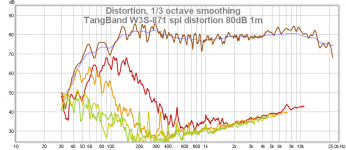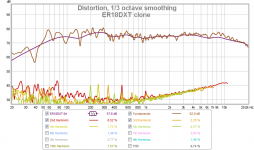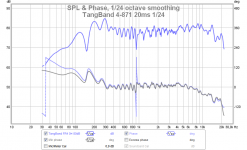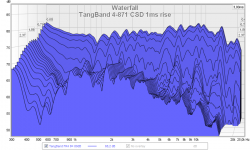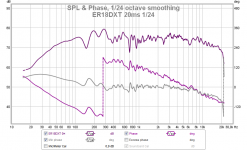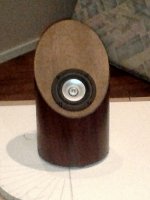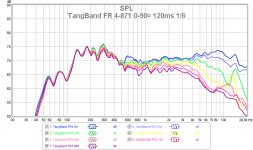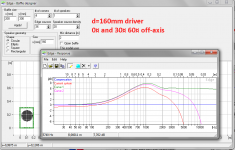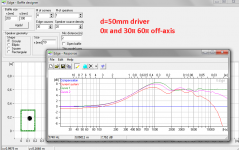So basically, if you make it so it's no longer a single full range, it works a lot better.
While truly a 2-way, FASTs are categorized as FR. Moving the XO really low solves all sorts of acoustic issues by removing many of the issues with having an XO (remember XOs are evil), primarily allowing driver spacing to fall under the critical 1/4 wavelength centre-to-centre criteria.
If one designs from this direction, there are FRs that have top ends as good as or better than most tweeters (normally one would give up bass to use these as single drivers).
dave
So if the question is are there widebanders which don't need a tweeter and can play down to (let's say) ~80hz, and which can't be improved by a tweeter nor filter, i would say yes -- but they are a very select category of ~3-4 inch drivers for nearfield bookshelves with a sub.
Does that count? Because they basically -are- tweeters with a low Fs, or small midranges with good treble extension. Still dynamically challenged but pleasing at least to some, for certain music. But I'm not sure you'd be happy with them if you aren't already a wideband fan.
+1
This is, IMO, the sweet-spot for FRs. Some of can get you into the 50s, some struggle to hit 90.
dave
If you have a recording with 30-35dB dynamic range, 105dB peak (which is what you were responding to) is not going to be all that loud at all if you can do it with reasonable distortion. If you're listening to a fuzzed out punk record with about 6dB of dynamic range, it's going to hurt.Why would you want to listen that loud?
I mentioned being loud as a requirement for "reference level", because to me "reference level" means playing back a recording of any of the usual acoustic instruments, uncompressed, at the original volume of the instrument. Probably an ill-advised side comment. I really only meant it as "I tend to spend my time thinking about speakers that can be run louder", not as a value judgement.
I could do that, too, I suppose. Remember I was only interested in comparing "full range" drivers against themselves with passive filters and HF help. So whatever bass extension or lack thereof, it wouldn't be a factor in the comparison....FASTs...Moving the XO really low...
If one designs from this direction, there are FRs that have top ends as good as or better than most tweeters (normally one would give up bass to use these as single drivers).
If you have a recording with 30-35dB dynamic range, 105dB peak
Few recordings have that much dynamic range. 20 dB above average is considered extremely dynamic. If you listen primarily to classic music you are more likely to run into them.
They are also 20 dB or more in the other direction... having exceptional DDR is necessary to encompass that, something many an XO tends to restrict.
dave
Remember I was only interested in comparing "full range" drivers against themselves with passive filters and HF help. So whatever bass extension or lack thereof, it wouldn't be a factor in the comparison.
That is not how i read it, but as you get into the larger FRs careful addition of a tweeter can more often add improvement, as you are typicaly giving up quality of the upper ranges to gain size (in the hope of better bass & dynamics).
To my mind, adding a woofer to a small FR makes a whole lot more sense (ignoring cost) than adding a tweeter to a large FR in most domestic situations.
dave
105dBA peak level is really not much. Typical handheld SPL meters report average level. I hardly ever play loud at home, but a hifi speaker should be comfortable producing max reasonable "authentic" levels.
3-4" fullrangers are sufficient for nearfield or kitchen radios etc. I have used TangBand 4-871 and CSS FR125
Here is response and distortion of TB in a closed 2 liter box. Notch filter by Zaph. Title say 3" but that is the real diameter of the membrane. Mic is calibrated and measuring distance is roughly 1m. Compare to SEAS ER18 playing at same spl
3-4" fullrangers are sufficient for nearfield or kitchen radios etc. I have used TangBand 4-871 and CSS FR125
Here is response and distortion of TB in a closed 2 liter box. Notch filter by Zaph. Title say 3" but that is the real diameter of the membrane. Mic is calibrated and measuring distance is roughly 1m. Compare to SEAS ER18 playing at same spl
Attachments
Last edited:
The TB W3-871 is a 3" driver with a cone size closer to 50mm. The other has a 7" woofer.
Cost difference is substantial.
By Geddes study distortion measures as you show are pretty much meaningless, and without off-axis, impedance, and phase response the rest of your graphs have little to tell us.
dave
Cost difference is substantial.
By Geddes study distortion measures as you show are pretty much meaningless, and without off-axis, impedance, and phase response the rest of your graphs have little to tell us.
dave
Here spl and phase of both. The TB shows some reflection artifact at 1kHz I guess. Also off-axis of TB. This is not the ultimate fullranger, just a diy table speaker with oval tilted baffle. Baffle was vertically in measurements
Small cones work ok high, but low end response and distortion is awful. Large ones have good low end but directivity, cone resonances etc. spoil their upper range. The classic alnico 8" drivers are midranges, minimal Xmax
Small cones work ok high, but low end response and distortion is awful. Large ones have good low end but directivity, cone resonances etc. spoil their upper range. The classic alnico 8" drivers are midranges, minimal Xmax
Attachments
Last edited:
Understandable, since I didn't explicitly say it. Let me try that again: The idea is to try to find a single-driver speaker that...That is not how i read it
- people seem to like for at least some sort of hifi purpose.
- at least some people expect can't be improved for its purpose, subjectively and/or objectively, with a tweeter and passive filter.
- I can afford to play with.
Then, the idea is to try to improve it with a tweeter and passive filter anyway, and see how easy/hard/impossible that proves to be for myself and anyone else playing along.
While truly a 2-way, FASTs are categorized as FR. Moving the XO really low solves all sorts of acoustic issues by removing many of the issues with having an XO (remember XOs are evil), primarily allowing driver spacing to fall under the critical 1/4 wavelength centre-to-centre criteria.
If one designs from this direction, there are FRs that have top ends as good as or better than most tweeters (normally one would give up bass to use these as single drivers).
dave
My point was that the whole point of the "full-rangers" is that you aren't supposed to need multiple drivers covering different frequency ranges and that if you're adding a lower range and a tweeter and a super tweeter, etc... you are basically making "stone soup"
IE. as TV tropes describes it -
Named for the classic folk tale in which a strange wanderer breezes into town and offers everyone a free bowl of his remarkable stone soup (made by putting his soupstone — a seemingly ordinary rock — into a pot of water and boiling it). The suspicious villagers have hidden their food, but the stranger slowly persuades them to add it to the pot, a little at a time, until at last they have contributed all the potatoes, onions, garlic, carrots, beef, turnips, parsley, salt, pepper, tomatoes, and bread to make a real meal.
I think the difference between a FAST and a conventional 2 way can be summarized by a test of disconnecting the bass driver. In a conventional 2 way it will sound like cr@p and unlistenable. In a FAST, it will still sound quite good and listenable, even enjoyable, just missing the very lower registers. The important range where most music content exists from 200 Hz on up is still preserved. One can always put that full range driver in a well designed box like a MLTL or BLH and most people will not need the woofer at all.
The stone soup analogy doesn't really apply here because the stone soup without all the accoutrements would still be quite tasty with just the rock and water.
The stone soup analogy doesn't really apply here because the stone soup without all the accoutrements would still be quite tasty with just the rock and water.
Last edited:
The FAST with the bass driver disconnected would be fairly compared to a 3-way with the woofer disconnected, not a 2-way. A 3-way with a comparably low xover point, of course. Not that it matters for what I want to do.
This demonstrates what kind of directivity 50mm and 160mm drivers have in same 200mm wide baffle. A whizzer cone gives a little better response but does it make some resonances, IM etc?
TangBand is actually the 3-871 and it's rigid cone d=50mm (I just measured it). ER18 rigid cone diameter is 160mm. Sorry I haven't measured my CSS FR125's performance.
TangBand is actually the 3-871 and it's rigid cone d=50mm (I just measured it). ER18 rigid cone diameter is 160mm. Sorry I haven't measured my CSS FR125's performance.
Attachments
Then, the idea is to try to improve it with a tweeter and passive filter anyway, and see how easy/hard/impossible that proves to be for myself and anyone else playing along.
What can you afford?
I'd suggest Mark Audio Alpair 7.3 or 10p. Then any of the other Alpairs. Fostex FF85wk if you can live with little bass and limited levels (an ideal FAST driver, and better than many a dome tweeter, even up to ~2x its price).
To bad EL70 is so hard to come by these days.
dave
Unless you're a tweeter, then they're your best friend. 🙂(remember XOs are evil)
I think the difference between a FAST and a conventional 2 way can be summarized by a test of disconnecting the bass driver. In a conventional 2 way it will sound like cr@p and unlistenable.
This is like the test they did on TopGear, where they "proved" a BMW M3 is more fuel efficient than a Prius, by driving them both at 80mph for a couple of hours.
In other words if you use something in a manner in which it is not intended to be used, it will "I'm shocked to learn that gambling is going on here." suck at it.
How good a subwoofer will your Full range be in a sealed box just large enough to contain the driver? Does the fact that it will suck at this mean it's useless?
The stone soup analogy doesn't really apply here because the stone soup without all the accoutrements would still be quite tasty with just the rock and water.
It also doesn't change the fact that a full range driver is inherently compromised. Current technology does not allow you to make a single driver that will cover 20Hz-20kHz well.
Last edited:
That's true George but my ears are happy with 50-15k which it seems to me is where most of the music is.
That's true George but my ears are happy with 50-15k which it seems to me is where most of the music is.
My point is basically that everything has trade offs and compromises. The mark of a good speaker design is after all how you minimize those compromises and maximize the strengths.
I don't have a problem with full rangers per se, but they aren't a panacea and aren't necessarily superior to a more conventional speaker. If they really were better than a conventional speaker and didn't have some serious drawbacks, I would expect to see them used a lot more. To be honest they mostly seem to be a novelty for people looking for something different for the sake of being different.
Mostly however, I just found funny the original post where they were talking about using 3+ full rangers to handle different frequency ranges, which is in many respects defeating the whole purpose of using a full ranger to begin with. At least as I have understood it.
- Status
- Not open for further replies.
- Home
- Loudspeakers
- Multi-Way
- "Full-range" v. 2-way: a group challenge?
